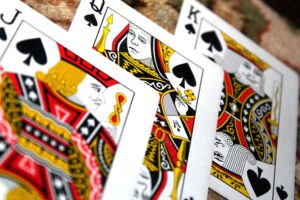Power Unveiled: Discover the Fascinating World of Poker Cards

Poker is a game that has captivated people for centuries, and one of the most essential elements of this beloved pastime is the deck of cards. The history of poker cards is a fascinating journey that spans across continents and centuries, evolving from simple playing tools to complex designs that we know today.
The Evolution of Poker Cards: From Origins to Modern Variations
The origins of poker cards can be traced back to ancient China, where card games were first played as early as the 9th century. These early cards were made from paper or ivory, featuring various symbols and characters. As trade routes expanded, these cards found their way to the Middle East, where they underwent further changes in design and structure.
It was during the 14th century that playing cards arrived in Europe, brought by merchants returning from their travels. European craftsmen quickly adopted these exotic cards and began producing their own versions, often adding intricate details and artistic touches. The suits we are familiar with today – hearts, diamonds, clubs, and spades – originated from these European adaptations.
Over time, different regions developed their own unique variations of poker cards. In Italy, the tarot deck emerged, featuring an additional set of trump cards used for divination purposes. In France, the modern standard deck took shape, with its distinctive court cards depicting kings, queens, and knights. This French deck became the template for many subsequent decks around the world.
As the popularity of poker spread throughout Europe and beyond, new variations of the game emerged, each with its own specific set of rules and card designs. In America, the game took on a new form during the 19th century, with the introduction of the Joker card as a wild card. This innovation added an extra layer of excitement and unpredictability to the game.
In recent years, the evolution of poker cards has continued with the rise of online gaming and the demand for customized decks. Today, players can choose from an array of designs, ranging from traditional patterns to themed decks featuring popular characters or motifs. These modern variations not only add a touch of personalization but also enhance the overall gaming experience.
While the designs and materials of poker cards have changed throughout history, their underlying purpose remains the same – to facilitate the game of poker and provide players with a means of communication and strategy. The intricate details and symbols on each card serve as cues for players, allowing them to assess their hands, make calculated decisions, and engage in the art of bluffing.
In conclusion, the evolution of poker cards is a testament to the enduring popularity and adaptability of this timeless game. From their humble origins in ancient China to the modern variations we see today, these cards have undergone numerous transformations, reflecting the cultural influences and technological advancements of each era. Whether playing with a traditional deck or a customized set, poker cards continue to captivate players worldwide, offering endless possibilities and an immersive gaming experience.
Strategies and Techniques for Mastering Poker Card Games
Poker is a game that has captured the hearts and minds of people all over the world. It is a game of skill, strategy, and luck, and mastering it requires a deep understanding of the cards that are used to play it. In this article, we will explore the fascinating world of poker cards and discuss strategies and techniques for mastering poker card games.
The standard deck of poker cards consists of 52 cards, divided into four suits: hearts, diamonds, clubs, and spades. Each suit contains thirteen cards: Ace, 2 through 10, and three face cards – Jack, Queen, and King. The face cards are often referred to as “court” or “picture” cards because they depict figures from medieval royalty. These cards hold special significance in poker games, as they have higher values than the number cards.
Understanding the value of each card is crucial when playing poker. The Ace is considered the highest-ranking card and can be used as both a high card and a low card depending on the context of the game. The number cards hold their face value, meaning a 2 is worth 2 points, a 3 is worth 3 points, and so on. The face cards – Jack, Queen, and King – are all worth 10 points each.
In addition to the four suits and thirteen ranks, poker cards also come with unique markings called indices. These indices indicate both the rank and suit of each card and are printed in the corners of the cards. The purpose of these indices is to allow players to quickly identify the value of their hand without having to turn the cards around. This feature is especially useful in fast-paced poker games where time is of the essence.
Now that we have covered the basics of poker cards, let’s dive into some strategies and techniques for mastering poker card games. One of the most important skills in poker is the ability to read your opponents’ hands. By observing their betting patterns, body language, and reactions to the community cards, you can gain valuable insights into the strength of their hand.
Another key strategy is understanding the odds and probabilities associated with different hands. Knowing the likelihood of certain combinations appearing on the table can help you make informed decisions about whether to bet, raise, or fold. This knowledge can give you a significant advantage over your opponents and improve your chances of winning.
Furthermore, learning how to bluff effectively is an essential skill in poker. Bluffing involves making your opponents believe that you have a stronger hand than you actually do. It requires a combination of confidence, timing, and reading your opponents’ reactions. However, bluffing should be used sparingly and strategically, as it can backfire if your opponents call your bluff.
In conclusion, poker cards are not just pieces of paper with numbers and symbols on them; they hold a world of strategy, skill, and excitement. Mastering poker card games requires a deep understanding of the value of each card, as well as strategies for reading your opponents, calculating odds, and bluffing effectively. So, next time you sit down at the poker table, remember the power that lies within those 52 cards and use it to your advantage.
Exploring the Artistry and Design of Poker Cards
Poker cards have long been a symbol of intrigue and fascination. These small pieces of paper hold within them the power to bring people together, challenge their minds, and even change their lives. But beyond their role in the game of poker, there is an entire world of artistry and design that goes into creating these iconic playing cards.
The artistry of poker cards can be traced back centuries, with each deck telling a unique story. From the intricate designs of the Renaissance era to the bold and vibrant colors of modern decks, the evolution of poker card design is a testament to human creativity and ingenuity.
One of the most famous examples of this artistry is the Bicycle playing cards, which have become synonymous with quality and craftsmanship. Designed in 1885, the Bicycle brand has stood the test of time and continues to be a favorite among players around the world. The intricate details of the card backs, the elegant fonts used for the numbers and suits, and the timeless color schemes all contribute to the overall aesthetic appeal of these cards.
But it’s not just about aesthetics – the design of poker cards also serves a practical purpose. Each card is carefully crafted to ensure maximum durability and ease of use. The size and weight of the cards are meticulously calculated to allow for easy shuffling and dealing, while the smooth finish ensures that they glide effortlessly across the table.
In addition to their design and functionality, poker cards also offer a glimpse into history. Many decks feature historical figures, landmarks, or events, providing a window into different cultures and time periods. For example, a deck inspired by Ancient Egypt might feature pharaohs, pyramids, and hieroglyphics, while a deck based on the Wild West might showcase cowboys, saloons, and wanted posters.
Another fascinating aspect of poker card design is the symbolism behind the suits. The four suits – hearts, diamonds, clubs, and spades – each have their own unique meaning. Hearts represent love and emotion, diamonds symbolize wealth and prosperity, clubs are associated with power and authority, and spades represent death and rebirth. These symbols add depth and intrigue to the game, elevating it from a mere pastime to a rich and meaningful experience.
Beyond their symbolism, poker cards also offer a canvas for artistic expression. Many artists and designers have used playing cards as a medium to showcase their creativity and push the boundaries of traditional design. From avant-garde decks that challenge our perception of what a deck of cards should look like to limited edition collaborations with renowned artists, there is no shortage of innovation in the world of poker card design.
In conclusion, exploring the artistry and design of poker cards unveils a fascinating world filled with history, symbolism, and creativity. From the timeless elegance of Bicycle playing cards to the bold experimentation of avant-garde designs, these small pieces of paper hold within them a world of possibilities. Whether you’re a casual player or a collector, taking a closer look at the intricacies of poker card design will surely deepen your appreciation for this timeless form of entertainment. So next time you sit down at the poker table, take a moment to admire the beauty and craftsmanship of the cards in front of you – they truly are a work of art.
Famous Poker Players and Their Impact on the World of Poker Cards
Poker is a game that has captured the hearts and minds of people all over the world. It is a game of strategy, skill, and luck, where players compete against each other to win money or valuable prizes. Over the years, there have been many famous poker players who have made a significant impact on the world of poker cards.
One such player is Doyle Brunson, often referred to as the “Godfather of Poker.” Brunson’s career in poker spans several decades, and he has won numerous tournaments and accolades. His expertise in the game has inspired countless aspiring poker players and has helped to popularize the sport. Brunson’s influence can be seen in the way poker cards are designed and marketed today. Many companies now produce poker cards featuring his image, and his signature appears on some decks as a mark of authenticity.
Another influential figure in the world of poker cards is Phil Ivey. Known for his exceptional skills and ability to read opponents, Ivey has become one of the most successful poker players in history. His strategic approach to the game has revolutionized the way players think about poker cards. Ivey’s impact extends beyond the table; he has collaborated with card manufacturers to create custom-designed decks that enhance gameplay and add an element of excitement to the game.
Daniel Negreanu is another renowned poker player whose impact on the world of poker cards cannot be overstated. Negreanu is known for his charismatic personality and his ability to connect with fans. He has used his popularity to promote poker cards as more than just tools for playing the game. Negreanu has worked closely with card manufacturers to develop unique designs that appeal to collectors and enthusiasts alike. His collaboration with various artists has resulted in visually stunning decks that have become highly sought after by poker aficionados around the world.
The influence of these famous poker players extends beyond their individual achievements. Their success has inspired a new generation of poker enthusiasts who are passionate about the game and its associated paraphernalia, including poker cards. Many players aspire to emulate the playing style and success of these legends, and this has fueled an increased demand for high-quality, custom-designed decks.
In response to this demand, card manufacturers have stepped up their game, producing innovative and visually appealing designs that cater to the tastes of modern poker players. These companies understand that poker cards are not just tools for gameplay but also objects of desire that reflect the personality and style of the player. As a result, there is now a wide variety of poker cards available on the market, ranging from traditional designs to avant-garde creations that push the boundaries of card design.
In conclusion, famous poker players have had a significant impact on the world of poker cards. Through their skill, charisma, and passion for the game, they have inspired a new generation of players and contributed to the evolution of card design. Poker cards are no longer seen as mere tools for playing the game but as collectible items that reflect the personality and style of the player. Thanks to these iconic figures, the fascinating world of poker cards continues to evolve and captivate audiences worldwide.






